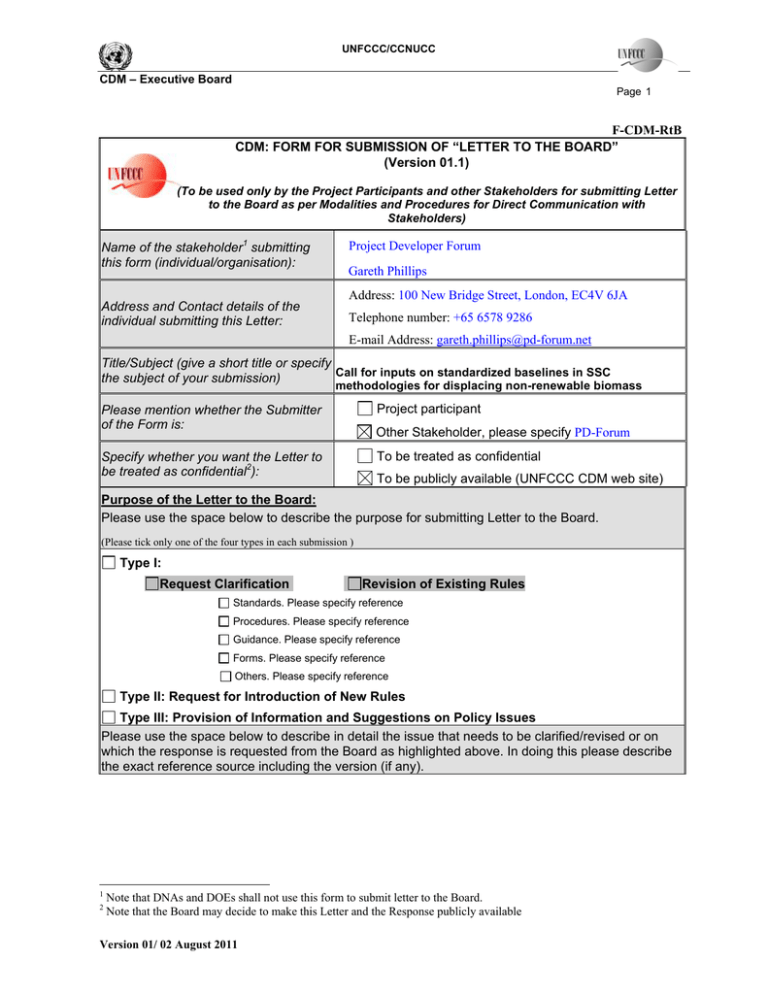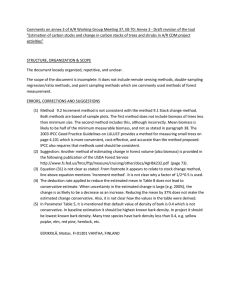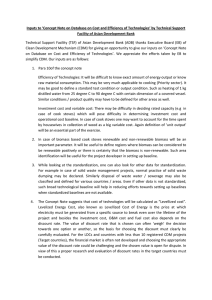Document 11120538
advertisement

UNFCCC/CCNUCC CDM – Executive Board Page 1 F-CDM-RtB CDM: FORM FOR SUBMISSION OF “LETTER TO THE BOARD” (Version 01.1) (To be used only by the Project Participants and other Stakeholders for submitting Letter to the Board as per Modalities and Procedures for Direct Communication with Stakeholders) Name of the stakeholder1 submitting this form (individual/organisation): Address and Contact details of the individual submitting this Letter: Project Developer Forum Gareth Phillips Address: 100 New Bridge Street, London, EC4V 6JA Telephone number: +65 6578 9286 E-mail Address: gareth.phillips@pd-forum.net Title/Subject (give a short title or specify Call for inputs on standardized baselines in SSC the subject of your submission) methodologies for displacing non-renewable biomass Please mention whether the Submitter of the Form is: Specify whether you want the Letter to be treated as confidential2): Project participant Other Stakeholder, please specify PD-Forum To be treated as confidential To be publicly available (UNFCCC CDM web site) Purpose of the Letter to the Board: Please use the space below to describe the purpose for submitting Letter to the Board. (Please tick only one of the four types in each submission ) Type I: Request Clarification Revision of Existing Rules Standards. Please specify reference Procedures. Please specify reference Guidance. Please specify reference Forms. Please specify reference Others. Please specify reference Type II: Request for Introduction of New Rules Type III: Provision of Information and Suggestions on Policy Issues Please use the space below to describe in detail the issue that needs to be clarified/revised or on which the response is requested from the Board as highlighted above. In doing this please describe the exact reference source including the version (if any). 1 2 Note that DNAs and DOEs shall not use this form to submit letter to the Board. Note that the Board may decide to make this Letter and the Response publicly available Version 01/ 02 August 2011 UNFCCC/CCNUCC CDM – Executive Board Page 2 Project Developer Forum Ltd. 100 New Bridge Street UK London EC4V 6JA To From Date Subject cdm-info@unfccc.int gareth.phillips@pd-forum.net 28 Oct 2011 Call for inputs on standardized baselines in SSC methodologies for displacing non-renewable biomass Europe: +44 1225 816877 Asia: +65 6578 9286 Americas: +1 321 775 4870 office@pd-forum.net www.pd-forum.net CHAIRMAN: Gareth Phillips t: +65 65789286 e: office@pd-forum.net Honorable Members of the CDM Executive Board and SSC Panel, Dear Mr. Hession, The PD Forum would like to thank the Executive Board for giving the opportunity for providing inputs into the work on standardising the approaches for displacing non-renewable biomass in small scale CDM projects. The project types using the methodologies AMS-I.E ‘Switch from non-renewable biomass for thermal applications’ and AMS-II.G ‘Energy efficiency measures in thermal applications of non-renewable biomass’ are good examples of the sustainable development benefits that the CDM can bring, in particular in the poorest areas such as LDCs and SIDS which are under-represented in the CDM. The PD Forum strongly believes that providing agreed standardised approaches and default factors can help simplify the process and reduce transaction costs for projects in the areas. However, the choice whether to use the default value should explicitly remain voluntary; as the default factors are determined at a high aggregate level and are conservative – project developers must still have the opportunity to use more local and accurate data. Para 1. a) approaches for deriving regional/country specific values for the fraction of nonrenewable biomass Specific feedback on (para 3): Practicality and appropriateness of the defined approaches for estimating the fraction of non• renewable biomass Both approaches mentioned in the SSC 33 Annex 8 are in principle valid approaches for determining highlevel aggregate fNRB at the level of the EB, or possibly individual DNAs, for providing default values that can be used on an ex-ante basis. However, the approaches do not necessarily seem appropriate for the use by single project developer for a small scale project: there are examples where the featured approaches derive a fNRB which is totally different from the local reality of the fraction of non-renewable biomass. The transaction costs associated with these two approaches are likely to be prohibitive for small scale projects which are likely to take place in the poorest areas in the world. Additionally, neither approach seems to take account of the existing guidance in the small scale methodologies and the definition of EB23 Annex 18, but rather re-interprets ‘non-renewable biomass’ in their own way. Therefore, these approaches are not fully consistent with existing methodologies and definitions as used in the CDM. There is a dearth of data in many regions where these project types are going to be implemented, and the approaches may not be possible in the regions. Therefore, the calculation of fNRB will need to use data that is already available. Version 01/ 02 August 2011 UNFCCC/CCNUCC CDM – Executive Board Page 3 • • The frequency with which the values for fraction of non-renewable biomass should be updated The fraction of non-renewable biomass is likely to be gradually increasing, due to population growth and other pressures, as is witnessed from the ongoing deforestation throughout particularly the most populous developing country regions. While the volumes of fuelwood consumed may be affected by economic growth, which may lead to some households switching to different technologies and fuels, updates of the default values are unlikely to be required more than once every crediting period. • • The level of aggregation that can reliably represent the non-renewability of displaced biomass We have found that the aggregation in the approaches in the SSC 33 Annex 8 is not always accurate. In particular around large urban areas in some countries there are strong distortions if the wrong aggregation level is used. While the actual fraction of non-renewable biomass is almost 100%, as evidenced by the rapid deforestation around the city and the ever-increasing distance from where fuel wood is imported in to the city’s markets, the WISDOM approach, for example, aggregates the urban areas and the surrounding province leading to incorrectly low fNRB. It would be obvious to an observer at the project site that fNRB is very close to 1. The level of aggregation that can reliably represent fNRB depends on the location. In some areas, particularly the most urbanised areas, biomass used is likely to be from a larger area and there may exist a formal market. In other areas, biomass may be sourced very locally. A local-level of aggregation needs to be an option for the project developer where data is available and if it is appropriate for the project. However, there are many countries where local-level data is not readily available and conducting surveys can be prohibitively expensive for project developers. Therefore, a higher aggregate level of data should also be allowed. • Other approaches for determining fNRB that should be assessed (e.g. net-to-gross adjustment with simple discount for baseline emission). If any, please provide further justification on the proposed approach(es) The PDF believe that the most appropriate approach in each country should be proposed by the DNA, based on the data availability. Further approaches are explained below. • Para 1. b) default parameters for baseline fuelwood consumption per capita or per household The availability of default values for baseline fuelwood consumption reduces the upfront costs for developing CDM projects of these types. However, it should always be possible for developers to determine more accurate values if they chose to do so. Specific feedback on (para 5): Whether providing default woodfuel consumption aggregated at a regional level is considered • practical from the project implementation point of view or if another level of aggregation would be more appropriate? The PDF believes that the aggregate regional level is appropriate, while more local values may • also be used where these are available, for example if values are published by DNAs. The availability of a default value could allow project developers to estimate the emission reductions ex-ante using the defaults, therefore avoiding upfront costs, even if more accurate data is obtained using surveys during the project operation as part of the monitoring. • • With what a frequency should these default values be updated? The quantity of fuelwood consumption by households will be relatively stable, as it is primarily dependent on cooking and eating habits of the population which do not change quickly. Volumes of fuelwood used per household are probably the same today as 20 or 30 years ago in most regions. However, quantities may be affected by economic growth and penetration of higherefficiency utilisation technologies. Economic growth will lead to some households switching to different technologies and fuels. Penetration of higher-efficient utilisation technologies is led by both the implementation of CDM projects and potentially by households becoming more affluent and able to afford more efficient and better stoves. Updates of the default values are unlikely to be required more than once every crediting period. Version 01/ 02 August 2011 UNFCCC/CCNUCC CDM – Executive Board Page 4 The default for North Africa seems particularly low, and we question whether the number is correctly reflecting the average consumption of households that use fuelwood, or the average consumption of fuelwood per household, including households using different fuels. While the other African regions have high shares of households using wood as their main fuel, this share is much lower in North Africa. Other approaches for determining fNRB that should be assessed The PDF believe that the most appropriate approach in each country should be proposed by the DNA, based on the data availability. Three further approaches are explained briefly below, based on: (1) published studies; (2) condition (a) of the SSC methodologies and EB23 Annex 18; (3) condition (b) of the SSC methodologies and EB23 Annex 18; and (4) a combination of conditions (a) and (b). (1) Published studies Published studies on the local or regional fuelwood utilisation which provide sufficient information to estimate the fraction of non-renewable biomass may already be available. Such studies have been carried out by national governments, including for example in their REDD readiness assessments, FAO, academic institutions and others. It should be possible for project developer to quote such studies without having to replicate the work and incur unnecessary transaction costs. (2) Condition (a) of the SSC methodologies and EB23 Annex 18 SSC methodologies AMS-1.E and AMS-II.G both define woody biomass as renewable if one of the following two conditions is satisfied, in line with EB23 Annex 18: The woody biomass is originating from land areas that are forests / non-forest areas (e.g. croplands, grasslands), where: (a) The land area remains a forest / non-forest areas; and (b) Sustainable management practices are undertaken on these land areas to ensure, in particular, that the level of carbon stocks on these land areas does not systematically decrease over time (carbon stocks may temporarily decrease due to harvesting); and (c) Any national or regional forestry, agriculture and nature conservation regulations are complied with. When using these definitions from the existing EB guidelines, default values for fNRB can be developed based on the national statistics collected by Food and Agriculture Organization of the United Nations (FAO) within the Forest Resources Assessment Programme (FRA). For example, based on the FRA statistics, it can be demonstrated that condition (a) is not satisfied for most African countries3, meaning that all woody biomass used leads to deforestation and declining of carbon stock and thus is non renewable. To demonstrate a specific country example of Tanzania, both forest and other wooded land areas there have been declining and non-forest areas (“other land” category) have been increasing which proves that condition (a) in the definition of renewable woody biomass is not satisfied. 4 Forest and non-forest areas in Tanzania according to FRA 2010 Categories Area in million hectares 199 200 200 5 0 5 Forest (including 41.5 37.5 35.4 plantations) Other wooded land 18.2 14.9 13.3 Other land 28.9 36.2 39.9 3 201 0 33.4 11.6 43.5 Global Forest Resources Assessment 2005, http://www.fao.org/forestry/32033/en/ Global Forest Resources Assessment 2010, Country Report, United Republic of Tanzania (FRA 2010), p14 http://www.fao.org/docrep/013/al657E/al657E.pdf 4 Version 01/ 02 August 2011 UNFCCC/CCNUCC CDM – Executive Board Page 5 With a rapidly declining forest area, the condition (a) is not met. Therefore, Demonstrably Renewable Biomass (DRB) is zero, and thus fNRB is 1. (3) Condition (b) of the SSC methodologies and EB23 Annex 18 Another simplified approach is based on condition (b) and assumes conservatively that all forest plantations are sustainably managed. While a general declining trend in forest area is observed in many countries, certain areas of forest might still have sustainable management practices. In most developing countries the statistics on management practices is not available. However, the main category of forests that is likely to be managed sustainably is plantations. Therefore, for simplification purposes we suggest to consider all biomass coming from plantations as DRB by default. Using the same example of Tanzania, plantations account for 240,000 hectares, while the total forested area is 33.4 million hectares. Therefore, if conservatively it is assumed that all plantations are sustainably managed, then fNRB = 1 – (plantations/total) = 1 – 240,000/33,400,000 = 0.9928. In addition, the declining trend in the carbon stocks is apparent in the statistics, which proves that condition (b) in the definition of renewable biomass is not satisfied either. Carbon stock in Tanzania according to FRA 2010 Year 1990 Carbon in above ground biomass 2,020 5 Carbon (Million metric tonnes) Forest Other wooded land 2000 2005 2010 199 200 200 0 0 5 1,824 1,725 1,628 770 630 558 201 0 491 The advantage of this approach is that it is easy, transparent and does not involve high transaction costs due to data collection, as opposed to the other proposed methods. (4) Condition (a) and (b) of the SSC methodologies and EB23 Annex 18 It is also possible to combine the approaches for greater conservativeness. First, it is shown that the land does not remain forest. Second, the fraction of non-renewable biomass is calculated from the area of plantations in the total, as the maximum share of land that is likely to be sustainably managed. Other issues It would be useful for these standardised baselines for displacing non-renewable biomass also to be available for large(r) scale projects. The logistics required for these project types is significant, and it should be possible to build on the logistical set up established and expand a successful project. Kind regards, Gareth Phillips Chair of the PD Forum 5 Ibid, p 35 Version 01/ 02 August 2011 UNFCCC/CCNUCC CDM – Executive Board Page 6 Please use the space below to any mention any suggestions or information that you want to provide to the Board. In doing this please describe the exact reference source including the version (if any). [replace this bracket with text, the field will expand automatically with size of text] • If necessary, list attached files containing relevant information (if any) [replace this bracket with text, the field will expand automatically with size of text] Section below to be filled in by UNFCCC secretariat Date when the form was received at UNFCCC secretariat ----History of document Version Date Nature of revision 01.1 09 August 2011 Editorial revision. 01 04 August 2011 Initial publication date. Decision Class: Regulatory Document Type: Form Business Function: Governence Version 01/ 02 August 2011







